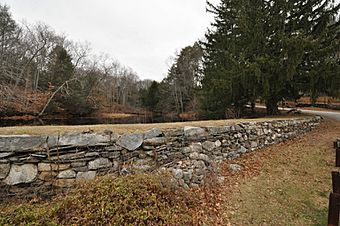Hemlock Glen Industrial Archeological District facts for kids
Quick facts for kids |
|
|
Hemlock Glen Industrial Archeological District
|
|

View of mill pond and remnant stonework
|
|
| Lua error in Module:Location_map at line 420: attempt to index field 'wikibase' (a nil value). | |
| Location | Hampton, Connecticut |
|---|---|
| Area | 6.3 acres (2.5 ha) |
| NRHP reference No. | 07000508 |
| Added to NRHP | June 05, 2007 |
The Hemlock Glen Industrial Archeological District is a special historical place in Hampton, Connecticut. It's where old factories and workshops used to be. These places were called "mills" and they used water power. They operated from the mid-1700s to the early 1900s. This important area was added to the National Register of Historic Places in 2007.
Contents
What is Hemlock Glen?
Hemlock Glen is a site with many old mill locations. These mills were built along a small river that flows into the Shetucket River. People settled in this area in the early 1700s.
Early Mills and Workshops
By 1745, there was already a sawmill and a gristmill here. A sawmill cuts wood, and a gristmill grinds grain into flour. These mills were rebuilt in 1776 by a man named John Fuller. Around the same time, a blacksmith shop also opened. It used water power too.
In 1814, John Fuller sold part of his land to Edward Badger, who was the blacksmith.
New Industries and Changes
Later, in the mid-1800s, new owners took over these properties. They started making new things like pins and silver spoons. This shows how industries changed over time.
A tannery also started operating around the 1810s. A tannery is a place where animal hides are turned into leather. This tannery worked for many years until a fire destroyed it in the 1850s.
The End of an Era
By the 1880s, the sawmill and blacksmith shop were no longer used. They were either abandoned or destroyed. The gristmill kept working until about 1925. It was likely destroyed by a big flood in 1938.
Why is Hemlock Glen Important?
Even though the buildings are gone, Hemlock Glen is very important for history. It's an "archaeological site." This means experts study the remains of old buildings and tools to learn about the past.
What Remains Today?
Today, you can still see parts of the old industrial activity. The main things left are the dam and pond from the gristmill. There are also dams and stone foundations from the other two sites. These are like clues that tell us about the past.
Learning from the Past
This site is special because the different mills were very close to each other. They were all within about 0.5 miles (0.80 km). This close setup helps experts understand how mill owners had to work together. They needed to share the water from the river. They had to make sure there was enough water for everyone's mill to run. Studying these old remains gives us a peek into how people lived and worked long ago.

